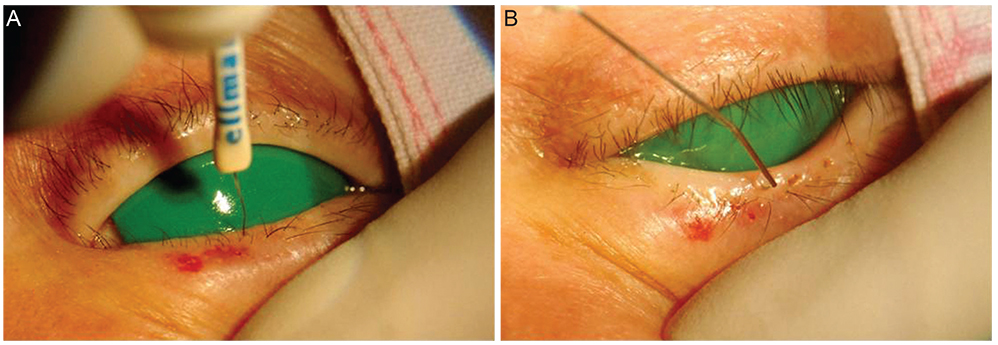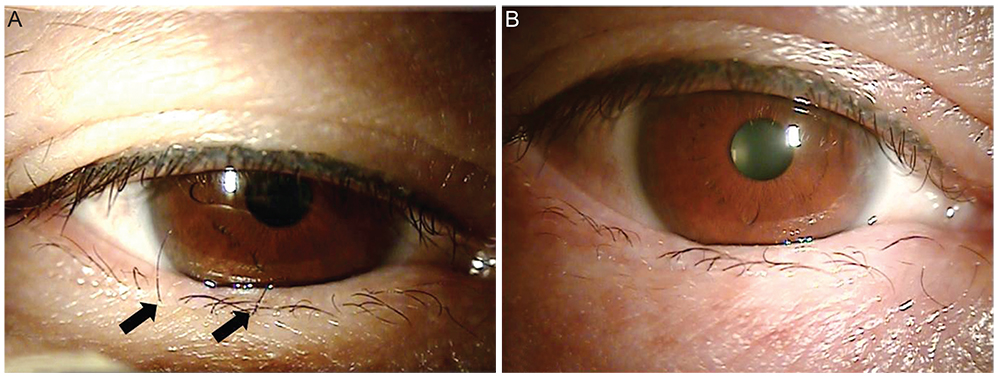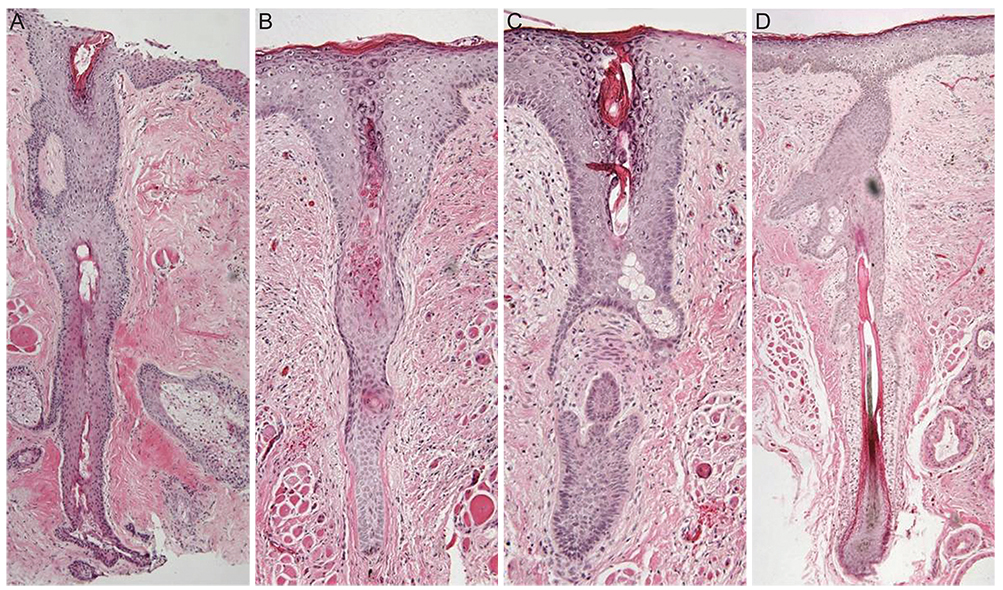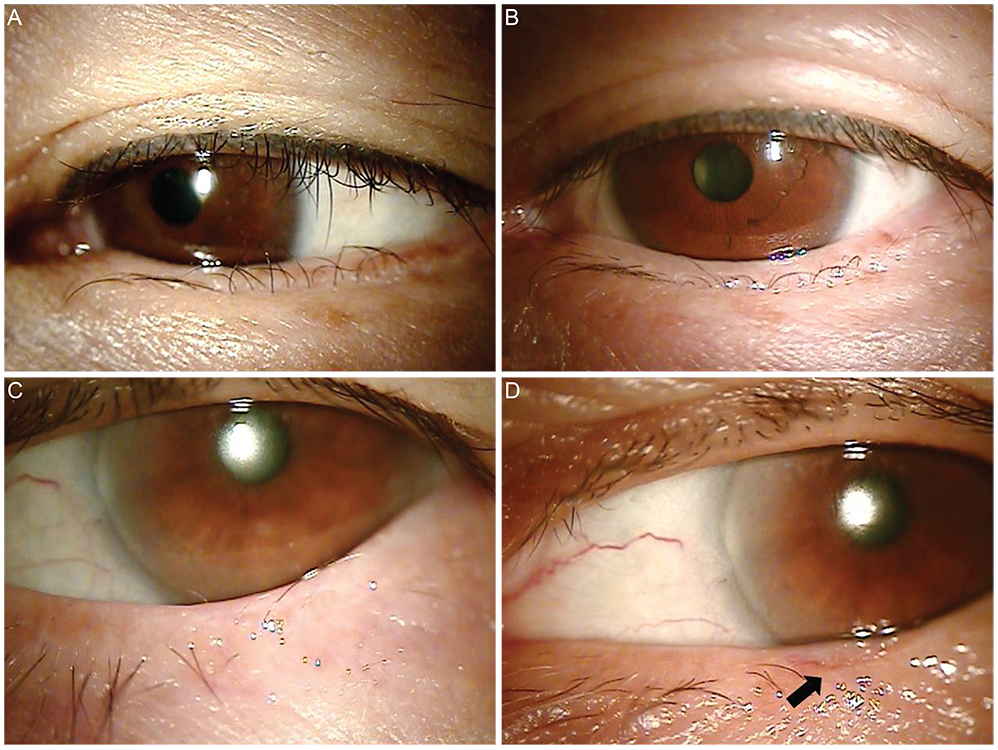Korean J Ophthalmol.
2014 Feb;28(1):12-18. 10.3341/kjo.2014.28.1.12.
The Effect of 0.02% Mitomycin C Injection into the Hair Follicle with Radiofrequency Ablation in Trichiasis Patients
- Affiliations
-
- 1Department of Ophthalmology, Gyeongsang National University School of Medicine, Jinju, Korea. stramast@naver.com
- 2Gyeongsang Institute of Health Science, Gyeongsang National University, Jinju, Korea.
- KMID: 1792089
- DOI: http://doi.org/10.3341/kjo.2014.28.1.12
Abstract
- PURPOSE
To investigate the inhibitory effect of 0.02% mitomycin C on eyelash regrowth when injected to the eyelash hair follicle immediately after radiofrequency ablation.
METHODS
We prospectively included 21 trichiasis patients from June 2011 to October 2012. Twenty eyes of 14 patients were treated with 0.02% mitomycin C to the hair follicle immediately after radiofrequency ablation in group 1, while radiofrequency ablation only was conducted in ten eyes of seven patients in group 2. Recurrences and complications were evaluated until six months after treatment.
RESULTS
One hundred sixteen eyelashes of 20 eyes in group 1 underwent treatment, and 19 (16.4%) eyelashes recurred. Eighty-four eyelashes of ten eyes in group 2 underwent treatment, and 51 (60.7%) eyelashes recurred. No patients developed any complications related to mitomycin C.
CONCLUSIONS
Application of 0.02% mitomycin C in conjunction with radiofrequency ablation may help to improve the success rate of radiofrequency ablation treatment in trichiasis patients.
Keyword
MeSH Terms
-
Antibiotics, Antineoplastic/administration & dosage
Catheter Ablation/*methods
Dose-Response Relationship, Drug
Eyelashes
Female
Follow-Up Studies
Hair Follicle
Humans
Injections
Male
Middle Aged
Mitomycin/*administration & dosage
Prospective Studies
Treatment Outcome
Trichiasis/diagnosis/*therapy
Antibiotics, Antineoplastic
Mitomycin
Figure
Reference
-
1. Gossman MD, Yung R, Berlin AJ, Brightwell JR. Prospective evaluation of the argon laser in the treatment of trichiasis. Ophthalmic Surg. 1992; 23:183–187.2. Basar E, Ozdemir H, Ozkan S, et al. Treatment of trichiasis with argon laser. Eur J Ophthalmol. 2000; 10:273–275.3. Kezirian GM. Treatment of localized trichiasis with radiosurgery. Ophthal Plast Reconstr Surg. 1993; 9:260–266.4. Kunitomo N, Mori S. Studies on pterygium: report IV. A treatment of the pterygium by mitomycin C installation. Acta Soc Ophthalmol Jpn. 1963; 67:601–607.5. Kim CR, Yoo WS, Kim KH, Seo SW. Effects of mitomycin C on eyelash-regrowth in epilated rats. J Korean Ophthalmol Soc. 2011; 52:1501–1506.6. West ES, Munoz B, Imeru A, et al. The association between epilation and corneal opacity among eyes with trachomatous trichiasis. Br J Ophthalmol. 2006; 90:171–174.7. Kormann RB, Moreira H. Treatment of trichiasis with high-frequency radio wave electrosurgery. Arq Bras Oftalmol. 2007; 70:276–280.8. Han JH, Doh SH. Treatment for trichiasis through a combination of eyelash trephination and electrocautery. Acta Ophthalmol. 2012; 90:e211–e213.9. Sakarya Y, Sakarya R, Yildirim A. Electrolysis treatment of trichiasis by using ultra-fine needle. Eur J Ophthalmol. 2010; 20:664–668.10. Elder MJ, Bernauer W. Cryotherapy for trichiasis in ocular cicatricial pemphigoid. Br J Ophthalmol. 1994; 78:769–771.11. Johnson RL, Collin JR. Treatment of trichiasis with a lid cryoprobe. Br J Ophthalmol. 1985; 69:267–270.12. Sullivan JH, Beard C, Bullock JD. Cryosurgery for treatment of trichiasis. Trans Am Ophthalmol Soc. 1976; 74:189–202.13. Sullivan JH. The use of cryotherapy for trichiasis. Trans Sect Ophthalmol Am Acad Ophthalmol Otolaryngol. 1977; 83(4 Pt 1):708–712.14. Wood JR, Anderson RL. Complications of cryosurgery. Arch Ophthalmol. 1981; 99:460–463.15. Sharif KW, Arafat AF, Wykes WC. The treatment of recurrent trichiasis with argon laser photocoagulation. Eye (Lond). 1991; 5(Pt 5):591–595.16. Bartley GB, Lowry JC. Argon laser treatment of trichiasis. Am J Ophthalmol. 1992; 113:71–74.17. Oguz H, Aras C, Ozdamar A. Thermoablation treatment for trichiasis in trachoma using the semiconductor diode pumped laser. Eur J Ophthalmol. 1999; 9:85–88.18. Ladas ID, Karamaounas N, Vergados J, et al. Use of argon laser photocoagulation in the treatment of recurrent trichiasis: long-term results. Ophthalmologica. 1993; 207:90–93.19. Yung CW, Massicotte SJ, Kuwabara T. Argon laser treatment of trichiasis: a clinical and histopathologic evaluation. Ophthal Plast Reconstr Surg. 1994; 10:130–136.20. Bi YL, Zhou Q, Xu W, Rong A. Anterior lamellar repositioning with complete lid split: a modified method for treating upper eyelids trichiasis in Asian patients. J Plast Reconstr Aesthet Surg. 2009; 62:1395–1402.21. Hintschich CR. "Anterior lamellar repositioning" for correction of entropion of the upper eyelid. Ophthalmologe. 1997; 94:436–440.22. Gower EW. Trichiasis: making progress toward elimination. Int Ophthalmol Clin. 2007; 47:77–86.23. Burton M, Solomon A. What's new in trichiasis surgery? Community Eye Health. 2004; 17:52–53.24. Khandekar R, Al-Hadrami K, Sarvanan N, et al. Recurrence of trachomatous trichiasis 17 years after bilamellar tarsal rotation procedure. Am J Ophthalmol. 2006; 141:1087–1091.25. Thanh TT, Khandekar R, Luong VQ, Courtright P. One year recurrence of trachomatous trichiasis in routinely operated Cuenod Nataf procedure cases in Vietnam. Br J Ophthalmol. 2004; 88:1114–1118.26. Khandekar R, Mohammed AJ, Courtright P. Recurrence of trichiasis: a long-term follow-up study in the Sultanate of Oman. Ophthalmic Epidemiol. 2001; 8:155–161.27. Bowman RJ, Faal H, Jatta B, et al. Longitudinal study of trachomatous trichiasis in The Gambia: barriers to acceptance of surgery. Invest Ophthalmol Vis Sci. 2002; 43:936–940.28. Chou SF, Chang SW, Chuang JL. Mitomycin C upregulates IL-8 and MCP-1 chemokine expression via mitogen-activated protein kinases in corneal fibroblasts. Invest Ophthalmol Vis Sci. 2007; 48:2009–2016.29. Chang SW, Chou SF, Yu SY. Dexamethasone reduces mitomycin C-related inflammatory cytokine expression without inducing further cell death in corneal fibroblasts. Wound Repair Regen. 2010; 18:59–69.30. Kligman AM, Peters L. Histologic changes of human hair follicles after electrolysis: a comparison of two methods. Cutis. 1984; 34:169–176.31. Khong JJ, Muecke J. Complications of mitomycin C therapy in 100 eyes with ocular surface neoplasia. Br J Ophthalmol. 2006; 90:819–822.32. Singh G, Wilson MR, Foster CS. Long-term follow-up study of mitomycin eye drops as adjunctive treatment of pterygia and its comparison with conjunctival autograft transplantation. Cornea. 1990; 9:331–334.33. Bindlish R, Condon GP, Schlosser JD, et al. Efficacy and safety of mitomycin-C in primary trabeculectomy: five-year follow-up. Ophthalmology. 2002; 109:1336–1341.34. Frucht-Pery J, Ilsar M. The use of low-dose mitomycin C for prevention of recurrent pterygium. Ophthalmology. 1994; 101:759–762.35. Thibaut S, De Becker E, Caisey L, et al. Human eyelash characterization. Br J Dermatol. 2010; 162:304–310.





